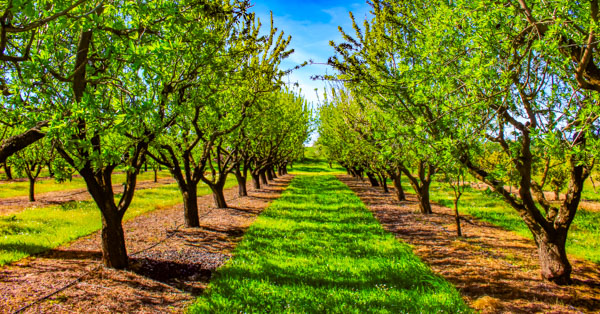Carbon sequestration in farming is the process of capturing and storing carbon dioxide from the atmosphere, preventing it from contributing to global warming. One of the most promising methods to sequester carbon is through farming practices.
Soil is the largest carbon accumulator amongst all of Earth’s ecosystems. Earth’s soil contains about 2,640 billion US tons of carbon within the first six feet below the ground. That’s three times as much as in the atmosphere. Nevertheless, human activities such as deforestation and conventional agriculture have degraded soil and released much of its stored carbon into the air.
The good news is that we can reverse this trend. We can do that by adopting more sustainable and regenerative farming techniques. These techniques not only help mitigate climate change, but also improve soil health, biodiversity, water quality, and crop output.
How does carbon sequestration in farming work?
Carbon sequestration in farming works by increasing the amount of organic matter in the soil. Soil which is composed of carbon-rich molecules derived from plants and microorganisms. Plants capture CO2 from the air through photosynthesis and further transfer some of ii into the soil through their root system. Microorganisms decompose these residues and convert them into organic matter (humus). Which is a stable form of soil organic matter that can persist for decades or centuries.
Here are some of the farming practices that can enhance soil carbon sequestration:

- Strip-Till farming: Strip-till or no-till farming involves planting seeds directly into the soil without plowing, which preserves soil carbon and reduces erosion. Or prepare only a narrow strip of soil (6 to 12 inches wide), leaving the rest of the soil surface covered with crop residue.
- Cover cropping: Cover crops are planted between main crops or during fallow periods to protect and supplement the soil. Cover crops such as clover, beans, and peas can fix nitrogen from the air and provide nutrients for the main crops. They also add organic matter to the soil when they are mowed or incorporated into the ground. Cover crops can increase soil carbon sequestration by up to 0.2 tons per acre per year.
- Agroforestry: Agroforestry is the integration of trees and bushes with crops or livestock on the same land. Trees and bushes can sequester carbon in their biomass above and below ground, as well as provide shade, windbreaks, habitat, and fodder for animals.
The benefits
Carbon sequestration in farming has multiple benefits for farmers, consumers, and the environment. Some of these benefits include:
- Climate change mitigation: Carbon sequestration reduces greenhouse gas emissions from agriculture and offset emissions from other sectors.
- Soil health improvement: Carbon sequestration in farming can improve soil health by increasing its organic matter content, water-holding capacity, nutrient availability, biological activity, and resistance to erosion and compaction. Healthy soils can support more diverse and resilient crops and reduce the need for synthetic fertilizers and pesticides.
- Food security enhancement: Carbon sequestration in farming can enhance food security by increasing crop yields and quality, as well as reducing crop losses due to droughts, floods, pests, and diseases. More nutritious and abundant food can also improve human health and well-being.
- Economic development stimulation: Carbon sequestration in farming can stimulate economic development by creating new income opportunities for farmers through carbon markets, payments for ecosystem services, or premium prices for organic products.
How to measure carbon sequestration in farming?
Measuring carbon sequestration in farming is not a simple task, as it involves estimating the changes in soil organic carbon (SOC) over time and space. SOC is influenced by many factors such as climate, soil type, land use history, management practices, and sampling methods.
Here are few of the diverse ways to measure Soil Organic Carbon:
- Laboratory analysis: This method involves collecting soil samples from different depths and locations within a farm field, drying, grinding, and analyzing them for their carbon content using chemical or physical techniques. This method is accurate but time-consuming, labor-intensive, and costly.
- Soil density measurement: This method involves measuring the soil bulk density, which is the mass of soil per unit volume, and multiplying it by the SOC concentration obtained from laboratory analysis. This method is faster and cheaper than laboratory analysis, but less accurate and more prone to errors.
- Remote sensing: This method involves using satellite or aerial imagery to estimate SOC based on the reflectance or emission of electromagnetic radiation from the soil surface. This method is rapid and scalable but requires calibration with ground data and may not capture the variability of SOC within a field or farm.
Farm management software for carbon sequestration tracking
By using practical farm management software, farmers can monitor and optimize their inputs, outputs, and practices to achieve greater efficiency and sustainability.
For example, farm management software can help farmers to choose the best crops, fertilizers, and irrigation methods for their soil and climate conditions, as well as track their carbon footprint and soil health. Additionally, farm management software can help farmers implement carbon farming practices, such as cover cropping, no-till, rotational grazing, and agroforestry, which can enhance the soil’s organic matter and carbon storage capacity.
If you are currently exploring farm management software options on the market, please try AgNote. You can register now and try it free for seven-days!